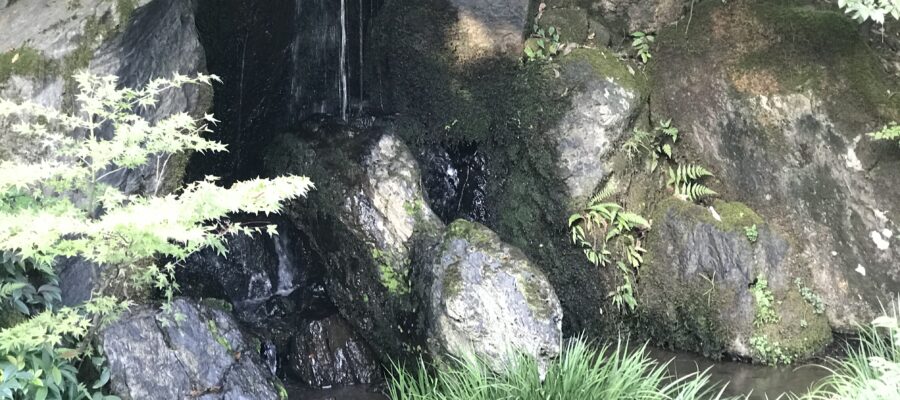金閣寺の鯉魚石
日本庭園を見学していて、滝つぼで滝に打たれる鯉の形をした石を見たことないでしょうか。いわゆる「鯉魚石」と言われるものです。金閣寺を回遊していても、金閣寺の鏡湖池を離れた辺りにある、龍門の滝にこの鯉魚石がありますが、ご存知でしょうか。中国の故事「登龍門」を知っている方も多いと思いますが、日本人なら鯉の滝登りから連想して、滝を登り切った鯉が龍に変わることをイメージできるのではないでしょうか。困難に打ち勝ち、立身出世するための登竜門です。
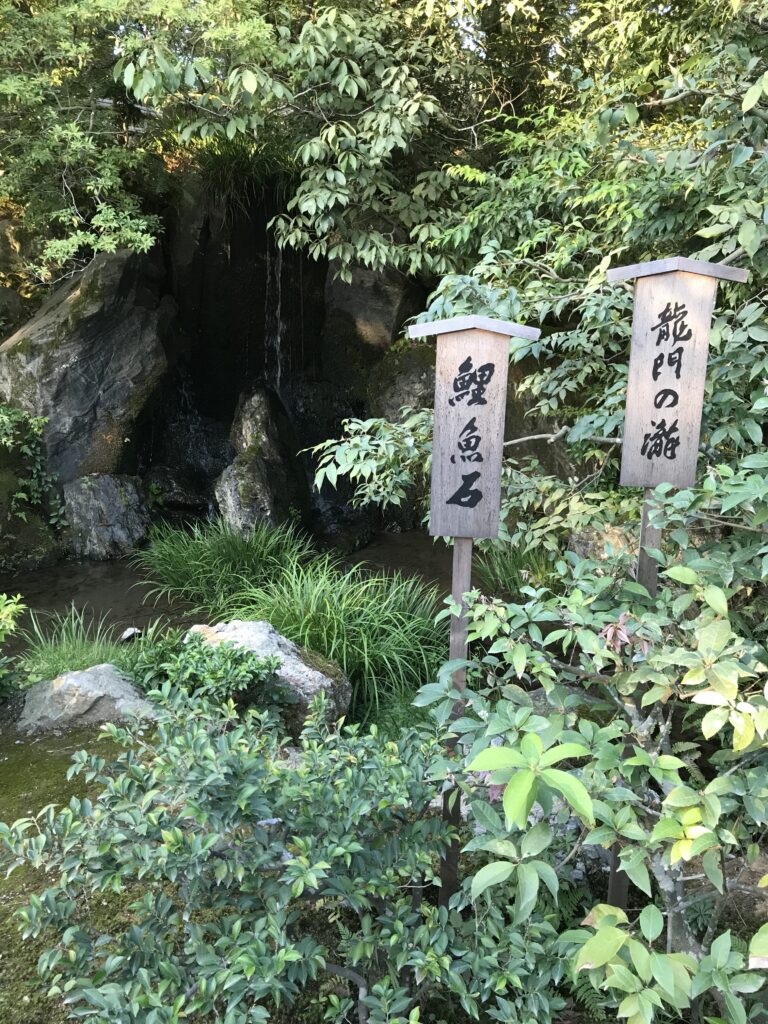
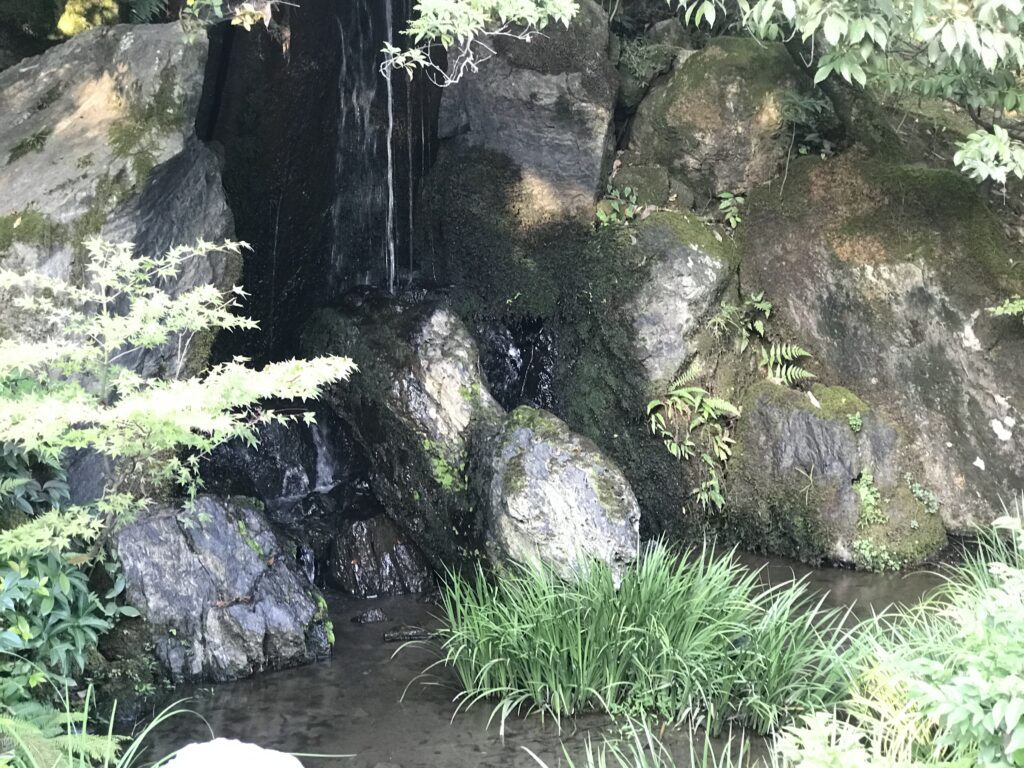
鯉と龍にどんな関係があるのか
では、なぜ鯉と龍が結びつくのか?長年疑問でしたが、ある説を聞いて少し関係が見えてきました。想像の生き物である龍は、角は鹿、頭はラクダ、爪は鷹、胴は蛇、そして鱗は鯉なのです。鯉が出世すると龍になるのは、あながち突飛ではないかもです。
西芳寺の鯉魚石
他に鯉魚石はないかと探してみると、苔寺として有名な西芳寺にあります。この姿は龍に変身する前の鯉の姿だそうです。苔の回遊式庭園から丘を上がっていくと、無造作に見える石組が現れます。なんだろうと思って、よくみると、真ん中に鯉魚石があります。石の形はバッタが、今にも飛びそうな姿勢に見えます。この石に気を留めて見ている人は誰もいませんが、私だけ何枚も写真を撮りました。よく講義で日本庭園の話をする際に、いつも鯉魚石のトピックスを混ぜていて、必ずここの石像を例として説明しています。やっと実物に会えました。
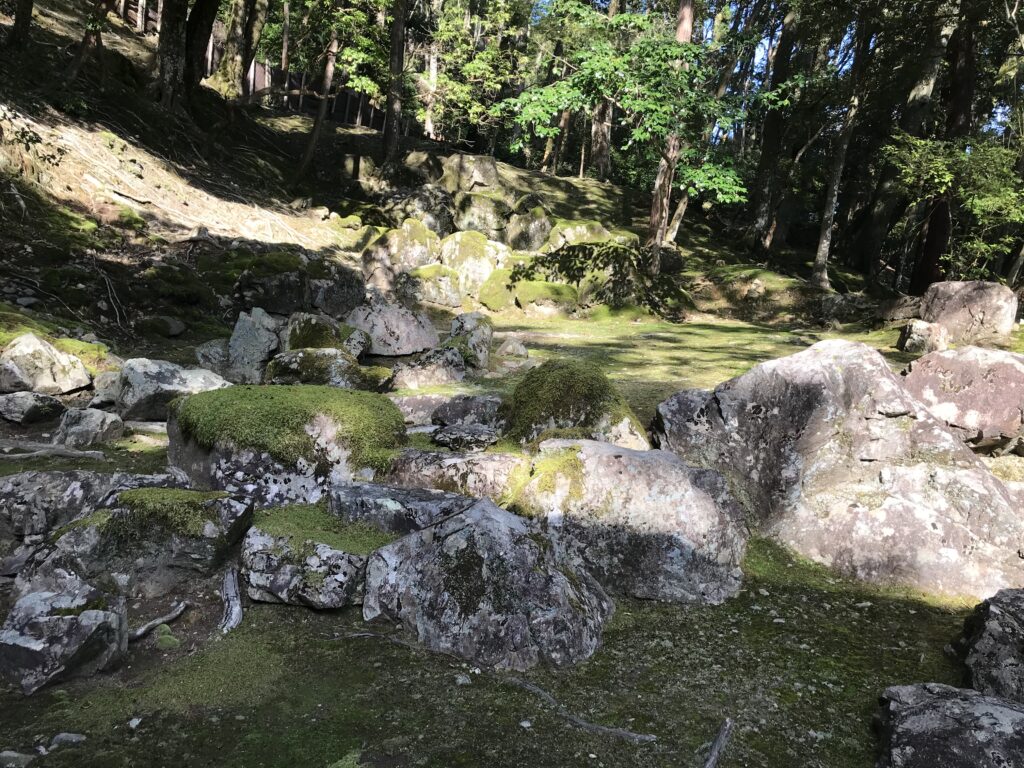
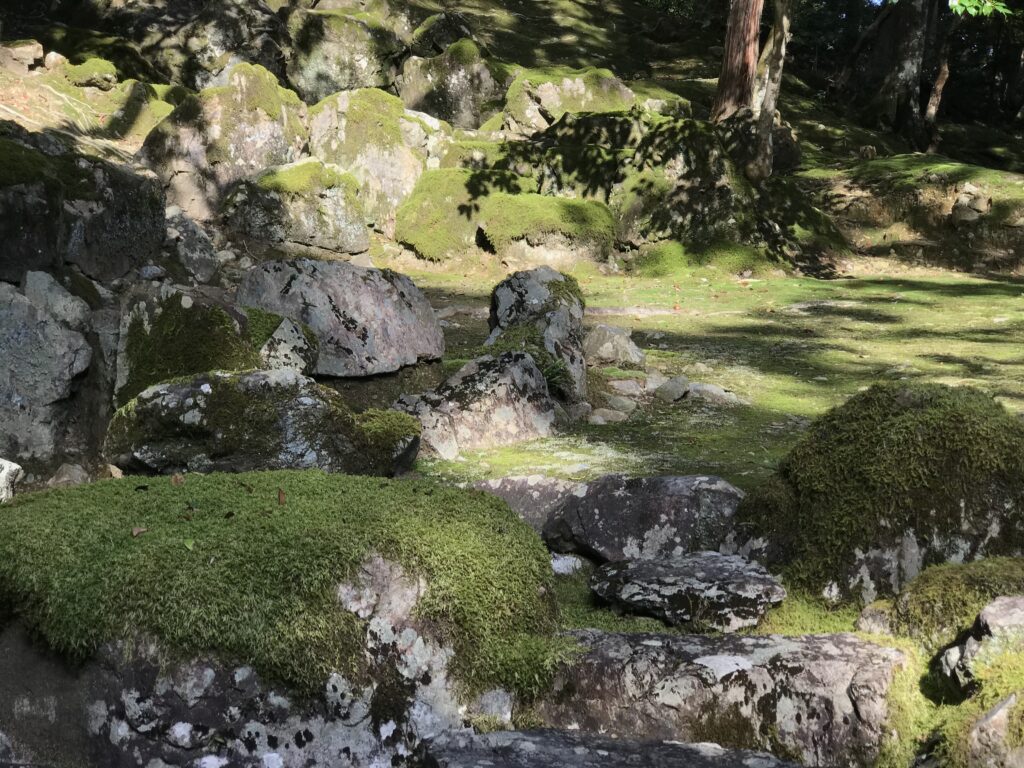
天龍寺の鯉魚石
もう一つ、天龍寺にも鯉魚石はあります。ここのは、今からまさに鯉から龍に変わろうとする姿だそうです。大方丈前の池泉回遊式庭園の対岸には、なにやら石組が配置されています。大方丈から池越しに見るため、単なる石の配列にしか見えず、気にかけない人の方が多いと思いますが、よ~く見ていただくと、鯉が一匹登っている姿が見えないでしょうか。一つの石で象られていいます。
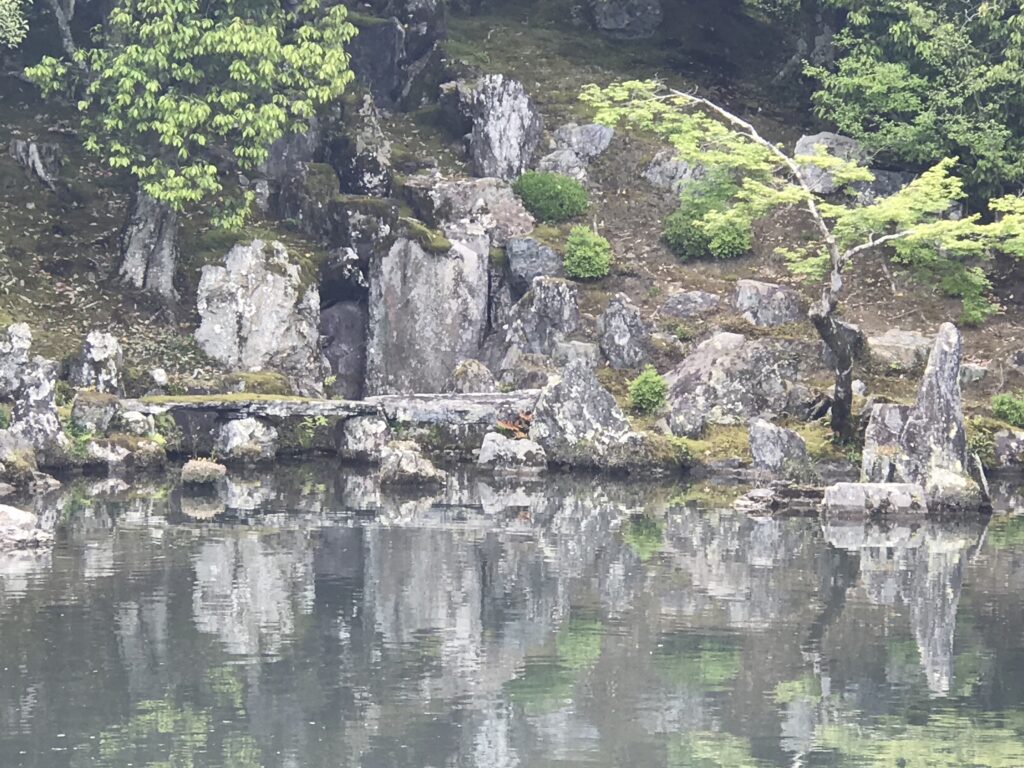
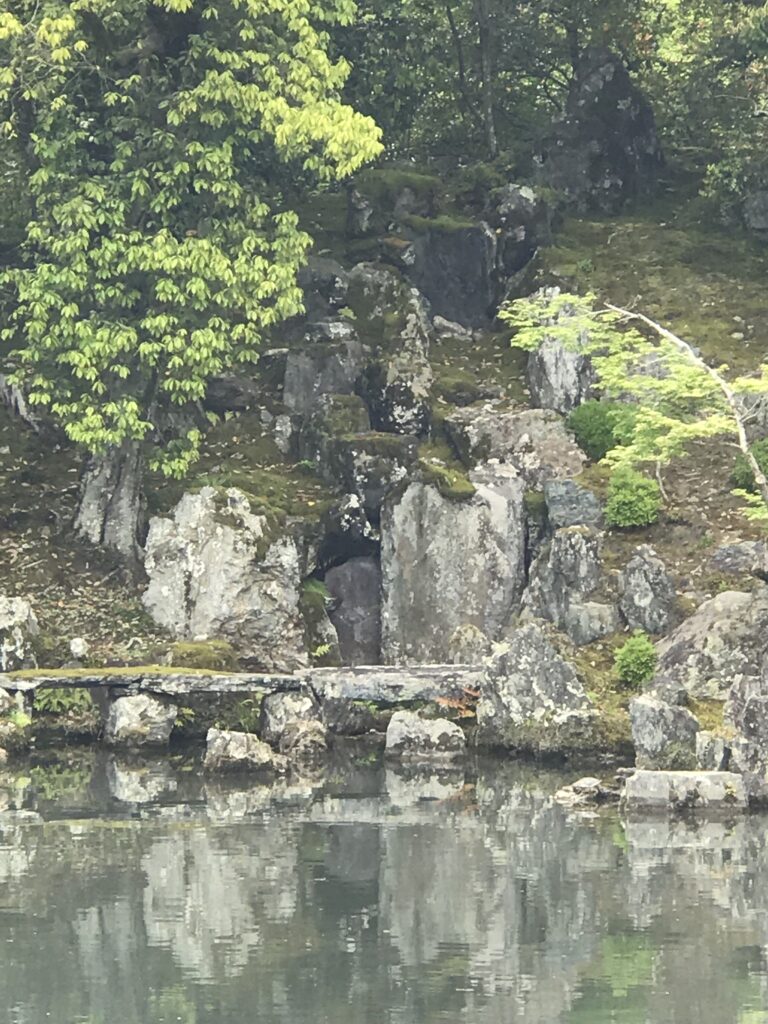
This is Carp Stone.
金閣寺に話を戻しますが、以前、鯉魚石について海外からの研修生に説明していると、何人かの若い訪日外国人を案内している外国人の方が、この石の前で立ち止まり、若い方々に向って、たった一言、“This is Carp Stone.” とだけ言って、そのまま彼らを引き連れて立ち去っていきました。えっ!それだけ?と驚く共に、外国人にはあまり興味がわかないものなのかなとショックを受けたことがあります。それでは、登竜門の話は好きなので、続けようと思います。(完)
鯉魚石について述べられている書籍
烏賀陽百合さんの「一度は行ってみんたい京都『絶景庭園』」に鯉魚石について述べられています。
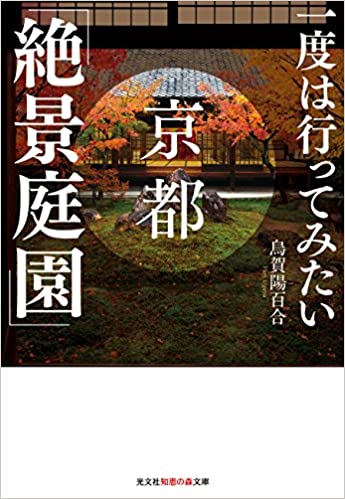
一度は行ってみたい京都「絶景庭園」 (光文社知恵の森文庫) [ 烏賀陽百合 ]
価格:924円
(2021/5/24 12:56時点)
感想(2件)
Carp Stones
Carp stone at Kinkakuji Temple
Have you ever visited a Japanese garden and seen a stone in the shape of a carp being struck by a waterfall in a waterfall basin? It is what is called a “Koi Fish (Carp) stone.” If you are touring around Kinkakuji Temple, you may have seen this koi fish stone at the Ryumon Waterfall, which is located away from the Kyoko-chi Pond of Kinkakuji Temple. Many of you may know the Chinese legend “Toryumon”, and Japanese people may associate it with carp climbing up a waterfall, and may be able to imagine that a carp that has climbed up the waterfall turns into a dragon. It is a gateway to success for overcoming difficulties and rising to the top.
What is the relationship between carp and dragons?
So why the connection between carp and dragons? I have wondered for many years, but after hearing a theory, I began to see a bit of a connection. The dragon, a creature of the imagination, has the horns of a deer, the head of a camel, the claws of an eagle, the body of a snake, and the scales of a carp. It may not be far-fetched to say that when a carp rises to the top, it becomes a dragon.
Koi fish stone at Saiho-ji Temple
Looking for other koi fish stones, I found one at Saiho-ji Temple, a famous moss temple. This figure is said to be that of a carp before it transforms into a dragon. As you walk up the hill from the moss garden, you will see a random-looking stone arrangement. Looking closely at it, you will see a carp fish stone in the center. The shape of the stone looks like a grasshopper poised to fly at any moment. No one pays attention to this stone, but I took many pictures of it. When I often talk about Japanese gardens in my lectures, I always mix in the topic of koi fish stones, and I always use the stone statues here as examples. I finally got to see the real thing.
Koi fish stone at Tenryuji Temple
There is another koi fish stone at Tenryuji Temple. The one here is said to be the very figure that is about to change from a carp to a dragon. On the opposite side of the pond garden in front of the Daihojo is a stone arrangement. Many people may not pay attention to it because it looks like a mere arrangement of stones as seen from the Daihojo over the pond, but if you look closely, you can see a carp climbing up the stone. It is a single stone.
This is Carp Stone.
Returning to the Kinkakuji temple, once when I was explaining the Koi-Fish-Stone to some trainees from overseas, a foreigner who was guiding some young visitors to Japan stopped in front of this stone, said only one sentence to the young people, “This is Carp Stone,” and walked away with them. What? That’s all? I was surprised and shocked to learn that foreigners do not have much interest in this stone. Now, since I like to talk about the gateway to success, I will continue. (End)
Pierres à carpe
Pierre de carpe au temple Kinkakuji
Avez-vous déjà visité un jardin japonais et vu une pierre ayant la forme d’une carpe frappée par une chute d’eau dans un bassin ? C’est ce qu’on appelle une “pierre de poisson koï (carpe)”. Si vous faites le tour du temple Kinkakuji, vous avez peut-être vu cette pierre de poisson koï à la cascade Ryumon, qui se trouve à l’écart du bassin Kyoko-chi du temple Kinkakuji. Beaucoup d’entre vous connaissent peut-être la légende chinoise “Toryumon”, et les Japonais l’associent à une carpe qui grimpe le long d’une chute d’eau, et peuvent imaginer qu’une carpe qui a grimpé le long de la chute d’eau se transforme en dragon. Il s’agit d’une porte d’entrée vers le succès pour surmonter les difficultés et atteindre le sommet.
Quelle est la relation entre les carpes et les dragons ?
Alors pourquoi le lien entre la carpe et les dragons ? Je me suis posé la question pendant de nombreuses années, mais après avoir entendu une théorie, j’ai commencé à voir un lien. Le dragon, créature de l’imaginaire, a les cornes d’un cerf, la tête d’un chameau, les griffes d’un aigle, le corps d’un serpent et les écailles d’une carpe. Il n’est peut-être pas exagéré de dire que lorsqu’une carpe s’élève au sommet, elle devient un dragon.
Pierre de poisson koï au temple Saiho-ji
En cherchant d’autres pierres de poissons koï, j’en ai trouvé une au temple Saiho-ji, un célèbre temple de la mousse. On dit que cette figure est celle d’une carpe avant qu’elle ne se transforme en dragon. En montant la colline depuis le jardin des mousses, vous verrez un arrangement de pierres d’aspect aléatoire. En y regardant de plus près, vous verrez une pierre de poisson-carpe au centre. La forme de la pierre ressemble à une sauterelle prête à s’envoler à tout moment. Personne ne prête attention à cette pierre, mais j’ai pris de nombreuses photos d’elle. Lorsque je parle souvent des jardins japonais dans mes conférences, j’y mêle toujours le sujet des pierres à poissons koi, et j’utilise toujours les statues de pierre ici comme exemples. J’ai finalement pu voir la vraie chose.
Pierre de poisson koï au temple Tenryuji
Il y a une autre pierre de poisson koï au temple Tenryuji. Celle qui se trouve ici est censée représenter la figure même qui est sur le point de passer de la carpe au dragon. De l’autre côté du jardin de l’étang, devant le Daihojo, se trouve un arrangement de pierres. Beaucoup de gens n’y prêtent pas attention car il ressemble à un simple arrangement de pierres vu du Daihojo au-dessus de l’étang, mais si vous regardez de près, vous pouvez voir une carpe grimper sur la pierre. Il s’agit d’une seule pierre.
C’est Carp Stone.
Pour en revenir au temple Kinkakuji, une fois, alors que j’expliquais la pierre de Koi-Fish à des stagiaires étrangers, un étranger qui guidait des jeunes visiteurs au Japon s’est arrêté devant cette pierre, n’a dit qu’une phrase aux jeunes, “C’est la pierre de Carp”, et est parti avec eux. Quoi ? C’est tout ? J’ai été surpris et choqué d’apprendre que les étrangers ne s’intéressent pas beaucoup à cette pierre. Maintenant, puisque j’aime parler de la porte du succès, je vais continuer. (Fin)
